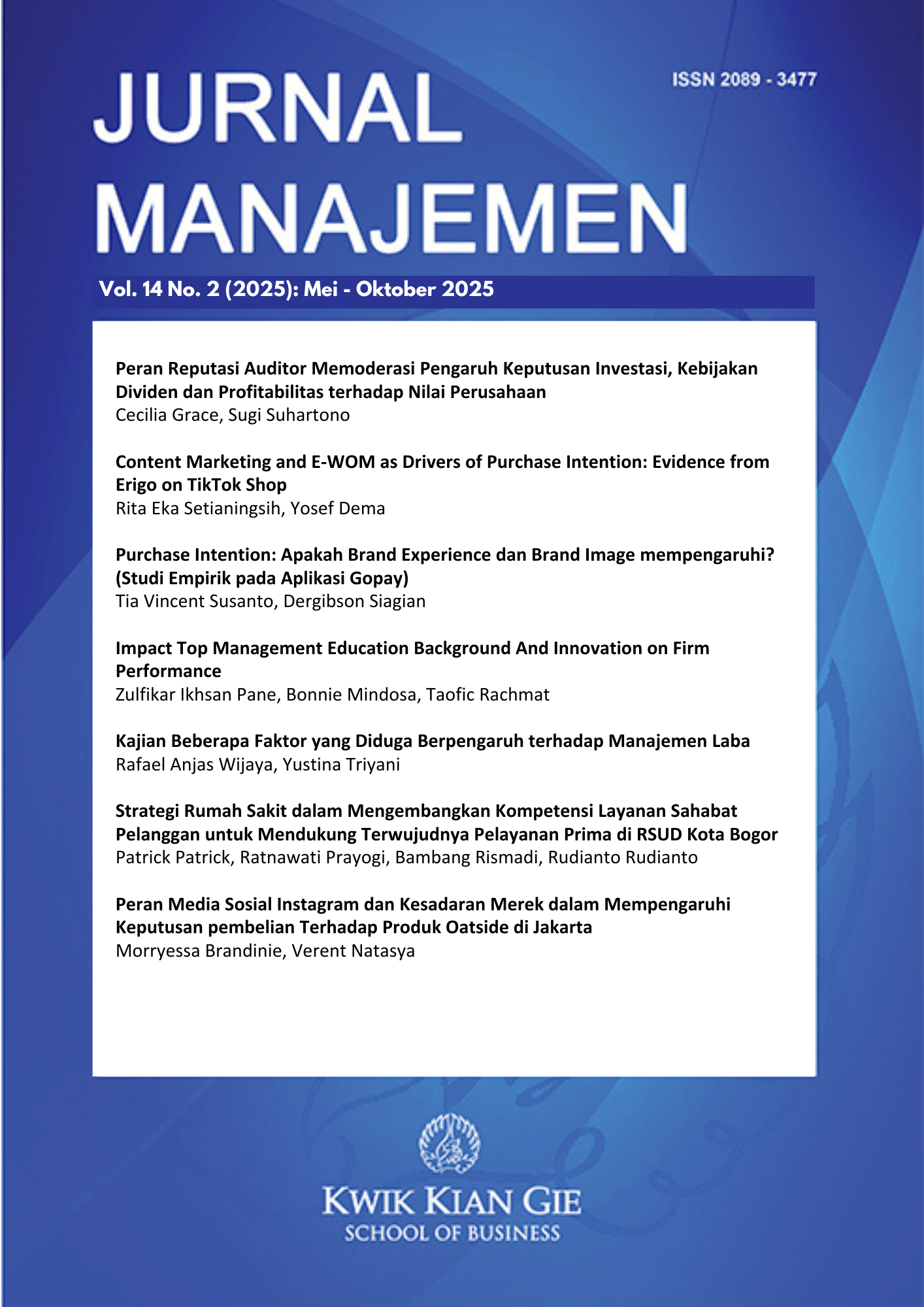Content Marketing and E-WOM as Drivers of Purchase Intention: Evidence from Erigo on TikTok Shop
Main Article Content
Abstract
In an era where scrolling replaces strolling and purchases are made with a tap, this study dives into the digital vortex to examine how content marketing and electronic word of mouth (E-WOM) shape the purchase intention of consumers toward Erigo, a rising local fashion brand, on TikTok Shop in Jakarta. As short-form video platforms redefine brand-consumer interaction, especially among digital-native youth, understanding the psychological triggers behind their buying behavior becomes paramount. Anchored in the Elaboration Likelihood Model (ELM) and the Theory of Planned Behavior (TPB), this research employs a quantitative approach with data from 103 purposively sampled respondents. The findings—generated via multiple linear regression using IBM SPSS 26—unveil a compelling narrative: both content marketing and E-WOM exert a significant and positive impact on consumer intent to purchase. Beyond the numbers, this study unpacks a deeper truth: in the fast-paced arena of social commerce, relatable content and authentic digital conversations are not just tactics—they are the strategy.
Downloads
Article Details

This work is licensed under a Creative Commons Attribution-NonCommercial-ShareAlike 4.0 International License.
References
Ajzen, I. (1991). The theory of planned behavior. Organizational Behavior and Human Decision Processes, 50(2), 179–211.
Bryman, A., & Bell, E. (2015). Business Research Methods (4th ed.). Oxford University Press.
Chae, Y. G., & Lee, K. C. (2021). Understanding the Influence of TikTok’s Interactive Features on Consumer Engagement and Purchase Intention. Asian Journal of Business Research, 11(3), 45–58.
Cheung, C. M., & Thadani, D. R. (2012). The impact of electronic word-of-mouth communication: A literature analysis and integrative model. Decision Support Systems, 54(1), 461–470.
DataIndonesia.id. (2024). Statistik Pengguna TikTok di Indonesia Tahun 2024. Retrieved from [dataindonesia.id]
Devi, L. A. P., Sutrisno, E., & Widayati, R. (2023). The Effect of Digital Marketing on Purchase Intention in the Fashion Industry. Jurnal Manajemen Pemasaran, 17(1), 1–9.
Dodds, W. B., Monroe, K. B., & Grewal, D. (1991). Effects of price, brand, and store information on buyers’ product evaluations. Journal of Marketing Research, 28(3), 307–319.
Fishbein, M., & Ajzen, I. (1975). Belief, Attitude, Intention, and Behavior: An Introduction to Theory and Research. Addison-Wesley.
Ghozali, I. (2018). Aplikasi Analisis Multivariate dengan Program IBM SPSS 25 (9th ed.). Badan Penerbit Universitas Diponegoro.
Hair, J. F., Black, W. C., Babin, B. J., & Anderson, R. E. (2014). Multivariate Data Analysis (7th ed.). Pearson Education Limited.
Hennig-Thurau, T., Gwinner, K. P., Walsh, G., & Gremler, D. D. (2004). Electronic word-of-mouth via consumer-opinion platforms: What motivates consumers to articulate themselves on the Internet? Journal of Interactive Marketing, 18(1), 38–52.
Hollebeek, L. D., & Macky, K. (2019). Digital content marketing’s role in fostering consumer engagement, trust, and value: Framework, fundamental propositions, and implications. Journal of Interactive Marketing, 45, 27–41.
Ismagilova, E., Dwivedi, Y. K., Slade, E., & Williams, M. D. (2020). The effect of electronic word of mouth communications on intention to purchase: A meta-analysis. Information Systems Frontiers, 22(5), 1203–1226.
Järvinen, J., & Taiminen, H. (2016). Harnessing marketing automation for B2B content marketing. Industrial Marketing Management, 54, 164–175.
Järvinen, J., & Taiminen, H. (2016). Harnessing marketing automation for B2B content marketing. Industrial Marketing Management, 54, 164–175.
Kapoor, K. K., Tamilmani, K., Rana, N. P., Patil, P., Dwivedi, Y. K., & Nerur, S. (2021). Advances in social media research: Past, present and future. Information Systems Frontiers, 23(2), 531–558.
Keller, K. L., & Swaminathan, V. (2019). Strategic Brand Management: Building, Measuring, and Managing Brand Equity (5th ed.). Pearson.
Kitchen, P. J., Kerr, G., Schultz, D. E., McColl, R., & Pals, H. (2014). The elaboration likelihood model: Review, critique and research agenda. European Journal of Marketing, 48(11/12), 2033–2050.
Kotler, P., & Armstrong, G. (2020). Principles of Marketing (17th ed.). Pearson.
Petty, R. E., & Cacioppo, J. T. (1986). The Elaboration Likelihood Model of Persuasion. Advances in Experimental Social Psychology, 19, 123–205.
Podsakoff, P. M., MacKenzie, S. B., Lee, J. Y., & Podsakoff, N. P. (2003). Common method biases in behavioral research: A critical review of the literature and recommended remedies. Journal of Applied Psychology, 88(5), 879–903.
Pulizzi, J. (2012). The rise of storytelling as the new marketing. Publishing Research Quarterly, 28(2), 116–123.
Putri, D. A., & Hidayat, R. (2022). The Influence of Electronic Word of Mouth and Content Marketing on Purchase Intention in the Fashion Industry. Jurnal Pemasaran Digital, 5(2), 101–115.
Ramadhani, R., Firdaus, M., & Lestari, N. (2022). Social Media Marketing in Shaping Purchase Intention: A Study on Indonesian Millennials. Jurnal Manajemen Pemasaran, 16(2), 120–130.
Spears, N., & Singh, S. N. (2004). Measuring attitude toward the brand and purchase intentions. Journal of Current Issues & Research in Advertising, 26(2), 53–66.
Statista. (2023). Social commerce growth through TikTok Shop in Southeast Asia. Retrieved from [statista.com]
Sugiyono. (2017). Metode Penelitian Kuantitatif, Kualitatif, dan R&D. Alfabeta.
Susanti, D., & Gunawan, T. (2021). The Effect of Content Marketing and E-WOM on Purchase Intention in Online Fashion Retail. Jurnal Ilmu Manajemen, 9(1), 55–67.
